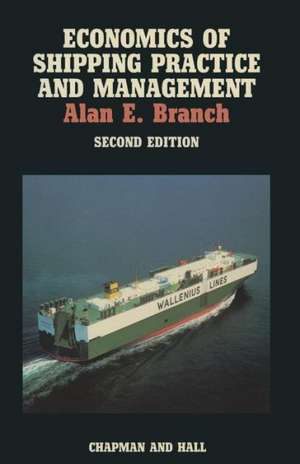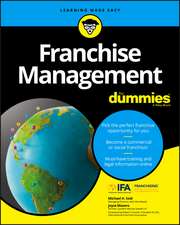Economics of Shipping Practice and Management
Autor A.E. Branchen Limba Engleză Paperback – 31 mar 1988
Preț: 641.20 lei
Preț vechi: 754.36 lei
-15% Nou
Puncte Express: 962
Preț estimativ în valută:
122.71€ • 127.33$ • 102.56£
122.71€ • 127.33$ • 102.56£
Carte tipărită la comandă
Livrare economică 17-31 martie
Preluare comenzi: 021 569.72.76
Specificații
ISBN-13: 9780412310300
ISBN-10: 0412310309
Pagini: 256
Ilustrații: 256 p. 2 illus.
Dimensiuni: 140 x 216 x 20 mm
Greutate: 0.44 kg
Ediția:Softcover reprint of the original 2nd ed. 1988
Editura: SPRINGER NETHERLANDS
Colecția Springer
Locul publicării:Dordrecht, Netherlands
ISBN-10: 0412310309
Pagini: 256
Ilustrații: 256 p. 2 illus.
Dimensiuni: 140 x 216 x 20 mm
Greutate: 0.44 kg
Ediția:Softcover reprint of the original 2nd ed. 1988
Editura: SPRINGER NETHERLANDS
Colecția Springer
Locul publicării:Dordrecht, Netherlands
Public țintă
ResearchCuprins
1 Services rendered by sea transport to international trade.- Function of shipping and its relationship to international trade. Balance of trade and balance of payments. Relationship between world seaborne trade and world mercantile fleet. International trade in the 1990s. Provision of shipping services in the 1990s. Flagging out..- 2 Economics of international trade.- Function of international trade. Survey of international trade. Commodity trades. Flow of manufactured goods. Multinational companies. Freight forwarding. Major trading areas of the world. Preferential trading groups. International exchange rates. Currency options. London International Financial Futures Exchange (LIFFE)..- 3 Economics of ship design.- Influence of cost, construction and safety factors. Ship design criteria. Economics of ship propulsion..- 4 Ship investment criteria.- Ship finance: crisis and remedy. Economics of new and second-hand tonnage. Methods of finance. Factors determining investment criteria. Changes in ownership and financial structure of the vessel. Analysis of national mercantile fleet investment policy..- 5 Economics of containerization.- Development of containerization. Development of container fleets..- 6 Roll on/roll off (Ro/Ro) vessels and their features.- Factors influencing development of Ro/Ro. Development of Ro/Ro market between UK and Europe. Ro/Ro vessels..- 7 Economics of ship operation.- Economics of ship manning. Factors to consider in planning sailing schedules. Surveys and maintenance. Survey methods. Problems caused by fluctuations and imbalances in trade. Fleet planning. Speed, frequency, reliability, cost and quality of service. Port operation. Offshore transhipment of bulk cargoes..- 8 The freight market.- Tramp and liner freight rates. International road haulage freight rates. Maritime container rates. International train ferry rates. Inland waterway freight rates. Short sea and estuarial passenger trades. The constituents of freight rates. Factors influencing the level of freight rates. Piracy and maritime fraud..- 9 Economics of chartering.- The determination of fixture rates. The charterer’s requirements. The Baltic Mercantile and Shipping Exchange. The Baltic International Freight Futures Exchange (BIFFEX). The Baltic and International Maritime Conference (BIMCO). Worldscale. Average freight rate assessments (AFRA)..- 10 Finance of international trade.- Export and import prices. Payments on ‘open account’. Bills of exchange. Documentary credits and allied documents. Transferable credits. Back to back credits. Revolving credits. Red clause credits. Acceptance credits. Factoring. Bank finance for exports. Finance guaranteed by the ECGD. Less common forms of trade. Changing methods of payment. Forfeiting..- 11 Counter-trade.- Forms of counter-trade. Counter-trade markets..- 12 Combined transport operation.- Combined transport concept. Containerization. International road haulage. Piggy back operation. Train ferries. Inland waterways..- 13 Ship management and marketing.- The shipping company. Shipping company consortia. Ship management companies. Shipping company mergers and acquisitions. Staff appraisals. Planning. Revenue, expenditure and investment budgets. Traffic and economic forecasts. Marketing. Market pricing. Market analysis. Market structure. Market share. Market research. Market forecasting. Media plan..- 14 Shipboard management.- Essentials of shipboard management. Organization of shipboard management. Operation of shipboard management. Advantages of shipboard management..- 15 Computerization.- Generalareas of software application. Cargo selection. Balancing of cargo flows. Inland transport. Pro forma voyage control. Sensitivity analysis. Case study. Negative aspects of data processing. Cargo (Ro/Ro) and passenger reservation systems. Types of available software program. Conclusion..- 16 Role of British and international shipping organizations.- Council of European and Japanese National Shipowners’ Associations (CENSA). General Council of British Shipping (GCBS). International Maritime Organization (IMO). International Association of Independent Tanker Owners (INTERTANKO). International Cargo Handling Co-ordination Association (ICHCA)..- 17 Role of other national and international organizations.- International Chamber of Commerce (ICC). International Labour Organisation (ILO). International Monetary Fund (IMF). Organisation for Economic Co-operation and Development (OECD). Organization of the Petroleum Exporting Countries (OPEC). Simplification of International Trade Procedures Board (SITPRO). United Nations Conference on Trade and Development (UNCTAD). United Nations Commission on International Trade Law (UNCITRAL)..- 18 Political factors.- The international trade scene. Flag discrimination. Liner conferences. Flags of convenience. Subsidies. The future..- Appendix A Further recommended textbook reading..- Appendix B Addresses of organizations and institutes engaged in the fields of shipping and international trade..- Appendix C Ship diagrams.
Recenzii
The author is to be congratulated on this new second edition of one of the most useful of basic books on the subject. The Seafarer; ...whatever shipping problem has to be studied, the use of this book is essential to ensure that no aspects of that problem are overlooked. It is recommended that any company in the business of shipping, place several copies of this book in their libraries for the permanent use by their senior staff. Marine Engineers Review









